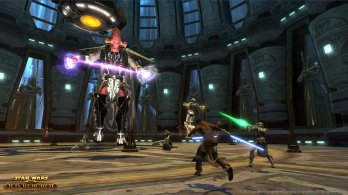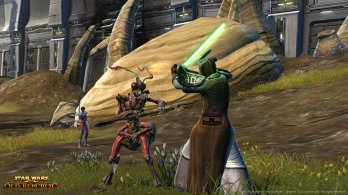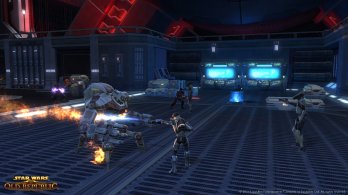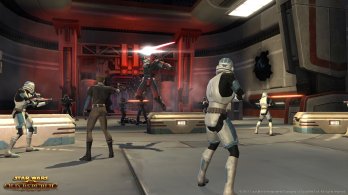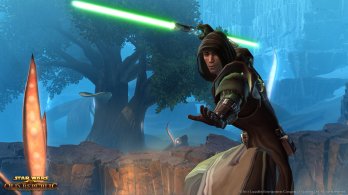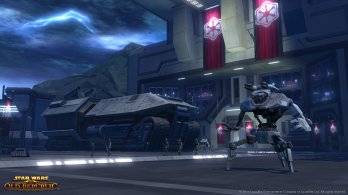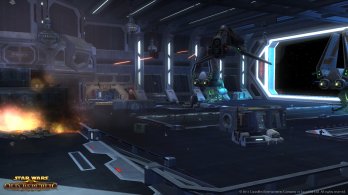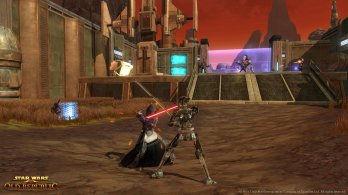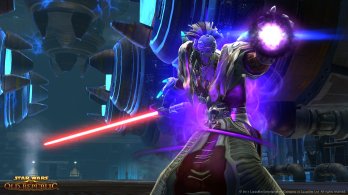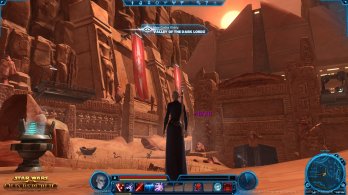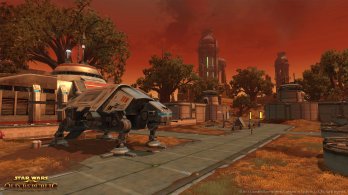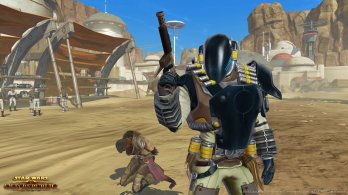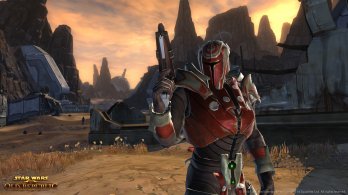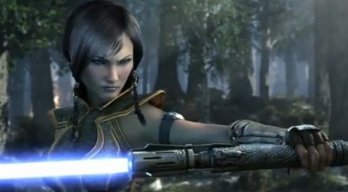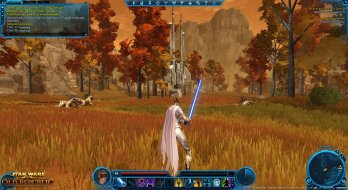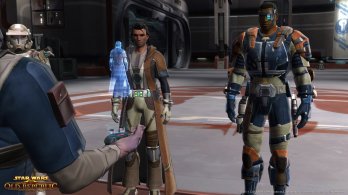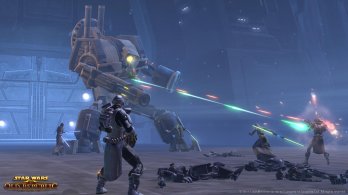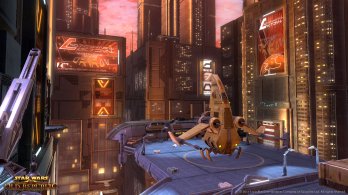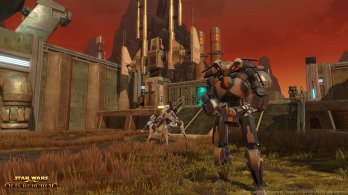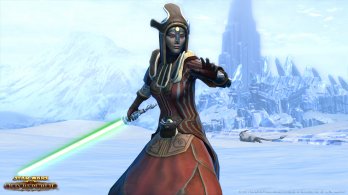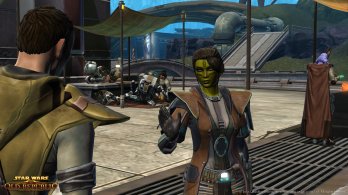
As far back as I can remember I’ve been playing RPGs, adventure games, and MMOs. As I sit here I can see Planescape Torment, Baldur’s Gate, Neuromancer, Final Fantasy, Wing Commander, the Crusader series, Septerra Core, Mass Effect, Bioshock, Kings Quest, BioForge, Pools of Radiance, Curse of the Azure Bonds, Shadow of the Beast, Maniac Mansion, and many more just to name a few. As the multiplayer market took hold, I found my interests expanded with the chance to play through these fantastic worlds with my friends. To date, I have played nearly all of the major MMOs that have hit the market since Richard Garriott changed the landscape of role playing games with Ultima Online. Breaking bread with my guild outside the town of Yew, taking on Crush and the Crushbone Orcs, laying siege to rival towns as a minotaur, listening to the lamentations of the (topless) women, leading guided tours through The Cathedral, and grinding out levels for Gil are just a few of the adventures I’ve shared with my friends, but there was always one adventure that escaped me – a proper Star Wars title. Sure, we all enjoyed our time in the single player titles from LucasArts, but the Sony-fueled Star Wars Galaxy MMO was a mess from inception. Arbitrary class rules, frustrating grinding, a pre-broken economy, player-driven riots, and far more squeezed every ounce of fun out of the game. While it did improve near the eventual demise of the title, it just never really captured the magic that is Star Wars.
When Bioware took the helm of the Star Wars franchise, critics and fans alike were absolutely blown away by their mastery of the subject matter. The legends of Darth Revan and the establishment of exciting new canon was met with equally compelling gameplay and dialog. The phrase “Meatbag” was added to every hardcore Star Wars fan’s lexicon, and the concept of flexible light and dark morality choices became a feature engrained in nearly every  Bioware game since. Knights of the Old Republic was heralded as one of the best games of all time, and is universally regarded as the best of all Star Wars titles. After watching their franchise suffer through Galaxies, it must have been an easy decision for LucasArts to allow Bioware to come back to the helm to reinvent their MMO.
Bioware game since. Knights of the Old Republic was heralded as one of the best games of all time, and is universally regarded as the best of all Star Wars titles. After watching their franchise suffer through Galaxies, it must have been an easy decision for LucasArts to allow Bioware to come back to the helm to reinvent their MMO.
Taking place 300 years after the conclusion of Knights of the Old Republic II, or roughly 3,500 years before the Star Wars movie saga, the galaxy far, far away finds itself under attack by the dark side. The Sith, a force rivaling that of the Jedi, has sieged the planet of Korriban re-establishing it as their dark domain in the universe. With the planet held, they’ve rebuilt the Sith Academy in the Valley of the Dark Lords. The Jedi retreat from Coruscant to the home of the Jedi Order – Tython. Both factions entrenched in their ancestral homes, a new galactic war has now begun…
Revan: “The apprentice has learned his final lesson.”
As I’ve mentioned a few times already, this game is Bioware-powered. While some critics complained that they didn’t like the changes in the combat style from Dragon Age to Dragon Age II, there isn’t a single critic that complains about a Bioware story. Compelling characters, well-written dialog, great voice acting, and a deep storyline with meaningful moral choices are the hallmarks of this studio, but bringing that into a genre that has been traditionally text driven would normally be quite difficult. Bioware had a solution that handled that nicely – a fully-voiced MMO.
Eschewing the usual “look for the guy with the exclamation point above his head, click on him, and then click accept” to blindly grab the next mission style, Bioware has built a completely unique experience with SWTOR. Using the 3-option system commonly found in their RPGs, players drive their own personal storyline with good, neutral, or evil choices through every mission. I emphasize the word every as Bioware did not cut any corners with this game – every mission no matter how trivial is completely voiced. More to the point, there really aren’t any trivial missions to be hand. You’ll never kill a rabbit, deliver a bottle of wine in a town, or any of the usual MMO trappings that usually keep you busy from levels 1-5. While you start off as a slave, Padawan, young soldier, rookie smuggler, a young trooper, or other humble beginnings, you’ll never feel like you aren’t powerful all on your own. Even as a Sith slave you’ll still possess skills and powers beyond that of a normal human being.
The storyline in most MMOs are guided entirely by the aforementioned always-skipped mission elements. While there are missions (again, fully voiced) that are shared commonly amongst all factions on the Republic or Empire side, there are 8 unique storylines that span from level 1 to level 50. These aren’t simple quests, but very involved quests that will drive how your character evolves. Those quests are then further subdivided between the advanced classes, giving players a vast and unique experience every time they play. While my Sith Sorcerer revels in torture and death, other Sith may manipulate and spare their enemies for other purposes. Similarly, my bounty hunter decapitated an enemy and handed the remains to his family, while other bounty hunters may choose to spare the target, sending him safely off-world. Since all of the story-driven missions are instanced for just the player, the choices you make exist in a vacuum. That is to say that killing or sparing a target is persistent in your universe, presenting or removing story elements in later chapters. A Jedi Knight that choses to execute a bested Sith Lord may pay for it with Dark Side points, but sparing this Lord may grant the fallen enemy the chance to redeem himself. This foe can re-forge his purpose and reappear in your storyline missions if given the chance. These meaningful choices help the player invest in the story and character, not just in the loot you collect.
that are shared commonly amongst all factions on the Republic or Empire side, there are 8 unique storylines that span from level 1 to level 50. These aren’t simple quests, but very involved quests that will drive how your character evolves. Those quests are then further subdivided between the advanced classes, giving players a vast and unique experience every time they play. While my Sith Sorcerer revels in torture and death, other Sith may manipulate and spare their enemies for other purposes. Similarly, my bounty hunter decapitated an enemy and handed the remains to his family, while other bounty hunters may choose to spare the target, sending him safely off-world. Since all of the story-driven missions are instanced for just the player, the choices you make exist in a vacuum. That is to say that killing or sparing a target is persistent in your universe, presenting or removing story elements in later chapters. A Jedi Knight that choses to execute a bested Sith Lord may pay for it with Dark Side points, but sparing this Lord may grant the fallen enemy the chance to redeem himself. This foe can re-forge his purpose and reappear in your storyline missions if given the chance. These meaningful choices help the player invest in the story and character, not just in the loot you collect.
HK-47: “You are a very harsh master, master. I like you.”
Another hallmark of the Bioware franchises is the concept of companions. As you play through from level 1 to 50 you’ll have the opportunity to pick up 5 companions. Each one has unique powers, their own storylines, and their own motivation. While Khem Val wants to see a vicious return to the world of the Dark Lords, Mako would be happy living as a good-hearted smuggler. Each companion reacts to your choices differently, granting positive or negative affection points. These affection points make your character more effective in their assigned tasks, as well as granting dialog and even romance options.
 Crafting is handled completely differently than in any other MMO. Your character is a Dark Lord, a Jedi Knight, a Bounty Hunter, or any other class that simply cannot be bothered with the grinding out and crafting of items. Your minions handle these tasks, freeing you up to continue your adventures. While you can only have one companion at a time, the others you collect can be dispatched to perform gathering skills or to craft new items. You can have one collecting skill, a crafting skill, and a secondary skill that you can usually use to grind out credits. These crafting skills fall into the usual categories, allowing players to craft enhancements or completely new pieces of light, medium, and heavy armors. While you can’t craft lightsabers, you are allowed to create modifications that enhance them in several areas.
Crafting is handled completely differently than in any other MMO. Your character is a Dark Lord, a Jedi Knight, a Bounty Hunter, or any other class that simply cannot be bothered with the grinding out and crafting of items. Your minions handle these tasks, freeing you up to continue your adventures. While you can only have one companion at a time, the others you collect can be dispatched to perform gathering skills or to craft new items. You can have one collecting skill, a crafting skill, and a secondary skill that you can usually use to grind out credits. These crafting skills fall into the usual categories, allowing players to craft enhancements or completely new pieces of light, medium, and heavy armors. While you can’t craft lightsabers, you are allowed to create modifications that enhance them in several areas.
One area where I feel that Bioware missed the boat, however is the Artifice skill. Artifice allows you make your own modifications for light sabers. Unfortunately, every weapon or piece of armor comes pre-modded with the exception of the items from the first few levels. This means that there is almost no market for the Artifice skill until you hit the top end. Other crafting skills have similar iissues to a smaller degree as well, but hopefully a few balancing patches could resolve all of these.
As individual as the moral choices are the class choices. While they do traditionally fall into archetypes such as healer, tank, and DPS, the choices afforded with points in your skill trees can greatly modify those choices. For instance, a Sith Sorcerer can be a healer, but with all points pushed into the Madness tree, they can also unleash lightning without cooldown, steal health from their foes, and far more. As with all MMOs, there are questions of  balance (some folks have said the Assassin is lacking at both ranges), but with nearly a dozen small balance patches since the game launched less than a month ago, it is clear that Bioware Austin is listening to fan feedback.
balance (some folks have said the Assassin is lacking at both ranges), but with nearly a dozen small balance patches since the game launched less than a month ago, it is clear that Bioware Austin is listening to fan feedback.
There are a few items that do need some work in SWTOR. For some reason, you cannot add friends that are offline, and the failure message (“X does not exist”) suggests that the person isn’t even on that server. With groups limited to just 4 players, healing isn’t all that difficult, but when you make it into the PvP Warzones, the lack of hover-targeting rears its ugly head. Finding a group can also be difficult as there is no conventional “Looking for Group” system beyond simply setting that flag on your character. This means that the “General” channel is full of “LF2M for Athiss” or other such requests.
Bastila Shan: “Eventually, I will challenge my master. If I am worthy, he will die by my hand.”
Let’s take a moment and talk about killing our fellow players. There are currently three Warzones for players to take on – Huttball, Voidstar, and Alderaan Civil War. Huttball is framed as a two-team Football knockoff. Running game, passing, and murder mix to allow players to square off Star Wars style. The field is riddled with acid baths, incinerators, and other traps line chokepoints between the two endzones, so naturally players with some sort of knockback ability are at an advantage here. Before you think this a disadvantage, know that a single point placed properly in the skill tree allows players to prevent or reduce knockback. Since, as it is in real football, there is a mad rush around the carrier you can bet that items like “Death Field” and “Death from Above” become very useful very quickly. Even the healer gets credit for keeping the ball carrier alive, so all classes are viable in PvE.
The second area is the Voidstar. The Voidstar reminds me heavily of old school CounterStrike. Defenders try to prevent the Attackers from assaulting their position and planting explosives. The attacking side needs 10 seconds to plant the charge, and the defenders can diffuse the charge in less than half that time. This means you will need to create artificial chokepoints and control the area to prevent the attacking team from reaching the holocron objective.
The third area is called the Alderaan Civil War. ACW is a capture and hold battle system, asking players to capture orbital gun turrets in attempts to destroy an incoming dropship. It is played 8 on 8, so the map is confined and tight. Of all three available PvE environments, I found this one to be the most fun. The map switches side quickly, and teamwork is absolutely necessary to capture and hold the guns.
Player-vs-Player is admittedly not my forte. In fact, single player RPGs are more my speed. The great part (for me) is that you don’t have to play PvP in any way. All of the missions for your story can be played with just you and your companion, and only Heroic quests require 2 or 4 players to complete. PvP is sequestered into Warzones, leaving the world fairly grief-free for players who enjoy that style of play. Those who enjoy combat with other players can join a PvP server and everyone becomes fair game. Similar to other MMOs, there are daily quests for PvP that grant additional gear and rewards. Since you can also gain experience in Warzones, there is also a great deal of potential to level up by some player slaughter.
HK-47: “Exclamation: Damn it, Master! I am an assassination droid, not a dictionary! “
With the focus so heavily rooted in story, it comes as no surprise that the Flashpoint system is essentially a small story in and of itself. Flashpoints are group instances for 2 to 4 players that provide not only fantastic gear, but also a snippet of story outside your main thread. Often they are assaulting a stronghold on the other side, mounting rescue missions, or taking down a crime lord. You can run these Flashpoints as often as you’d like, but there are small variations (both based on your choices, as well as plain randomness) in them to keep them fresh. The Black Talon flashpoint on the Sith side, meant for level 12 or so, can be run for additional social points and light/dark side points as often as you’d like. While they are entirely optional they are a lot of fun, breaking up often far more serious missions.
Speaking of breaking up the storyline, every player gets a space craft of some kind. These serve as storage, as well as conveyance to new worlds. It also gives you the opportunity for space combat. While this isn’t X-Wing reborn, you do get an on-rails distraction that allows you to shoot down some NPC craft and assault the odd carrier-class craft or two. These missions are entirely optional, granting a bit of arcade action in an otherwise completely RPG-driven game. I’m not sure how many people are playing these missions, but I really don’t hear a lot of chatter about them. I have played through five or so in the 50+ hours of gameplay I’ve put in since launch, so I’m suspecting it isn’t many.
Savior. Conqueror. Hero. Villain. You are all things Revan, and yet, you are nothing.
Here at Gaming Trend we normally wait through a few patches to see how an MMO shapes up before writing a review. This is done to see just how well the community supports the new product, as well as how patches are handled. Star Wars: The Old Republic has had one of the smoothest launches I’ve seen from any MMO to date. It also manages to handle both single player, multiplayer, massive multiplayer, PvE, PvP, and small groups as well as large in one package. Anyone playing this game can’t help but crack a smile when they get their first lightsaber, and that’s just the start. The game is full to bursting with epic storylines (the developers estimate roughly 800 hours – and that’s not a typo), solid voice acting, and enough content to keep you busy for the foreseeable future. The Old Republic hasn’t raised the bar for MMOs, it completely reinvents the genre entirely.
Ron Burke is the Editor in Chief for Gaming Trend. Currently living in Fort Worth, Texas, Ron is an old-school gamer who enjoys CRPGs, action/adventure, platformers, music games, and has recently gotten into tabletop gaming.
Ron is also a fourth degree black belt, with a Master's rank in Matsumura Seito Shōrin-ryū, Moo Duk Kwan Tang Soo Do, Universal Tang Soo Do Alliance, and International Tang Soo Do Federation. He also holds ranks in several other styles in his search to be a well-rounded fighter.
Ron has been married to Gaming Trend Editor, Laura Burke, for 28 years. They have three dogs - Pazuzu (Irish Terrier), Atë, and Calliope (both Australian Kelpie/Pit Bull mixes), and an Axolotl named Dagon!

See below for our list of partners and affiliates:
